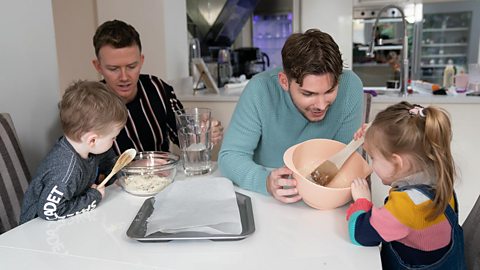It doesn't have to be Pride Month to chat to your child about LGBTQ+ communities around the world.
Learning about different family units with your little one is a great way to show the importance embracing differences.
Weâve been chatting to some LGBTQ+ families to get some top tips on celebrating pride and talking about different types of families with a young child.
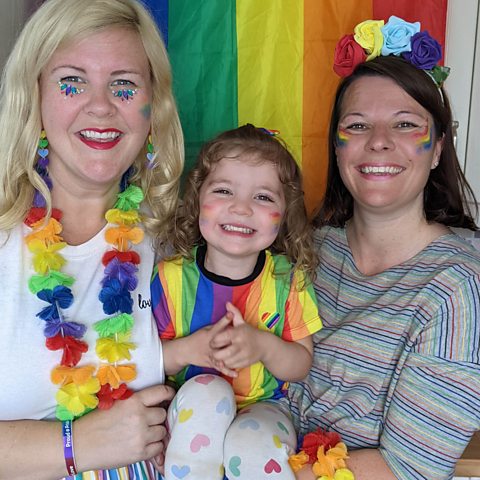
âPride is like Christmas in our house!â
Sarah and Laura Smith are parents to Annabelle and Matilda. Sarah says:
âWe met at work in 2008 - Iâm from Reading, and Laura is from Idaho in the US. We didnât even like each other at first. But after five months of working together, we became friends and then started dating in March 2009. It was the first time either of us had been in a same-sex couple. Even though we loved each other, we didnât think weâd have the life we do now. At the time, we didnât know anyone like us or have any role models to show us what our life could be like together.
âBut it feels like society has moved on at the same time as our relationship. In 2014 we were the first female couple to be legally married in Westminster borough. It was amazing to be part of history. In 2017 we decided to try for a family and, after our first round of IVF, got pregnant. We totally believe that the things that make people unique are their superpowers!â
âItâs about celebrating our differencesâ
Laura says: âPride is a bit like Christmas in our house. On 1 June, we get out all our rainbow decorations, headgear and clothes. Annabelle loves dressing up, and we dance around to Pride playlists. Sheâs too young to understand the history of Pride, but weâve explained weâre supporting people just like us. She then brings down her books about having two mums and reads them all over again.
âAnnabelleâs nursery have been very involved and have made rainbow cakes and done rainbow arts and crafts with the children. Weâve taken in a few books about LGBTQ+ families and other family units that they are reading to the kids too. Itâs all about celebrating our differences.â

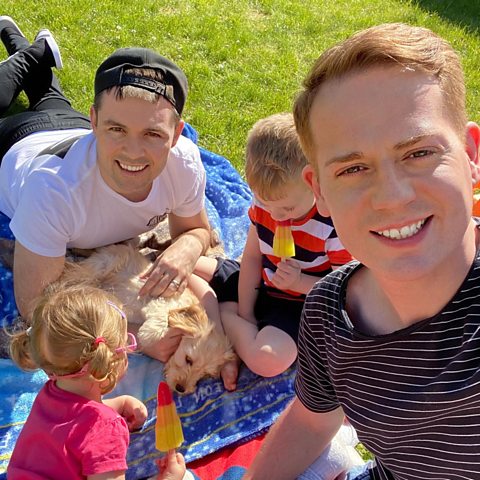
âHaving a different family dynamic isnât an issueâ
Rich and Lew are the adoptive parents of a six-year-old son and three-year-old daughter. Rich says:
âWe met in a pub in 2013. At the time I wasnât openly gay (the friends I was with didnât know), so I gave Lew my number on a piece of paper. He called me a few days later, and we started dating. Weâre very different - Iâm a mortgage adviser and, at the time, Lew was a dancer on the Sesame Street Live tour - but we just clicked. After about 18 months, we started talking about having a family. We decided adoption was the best option for us and in 2015, after a long process, we adopted our son. We got married in 2017 and the year after we adopted our daughter.
We went away to Cornwall recently, and our son made friends with another boy. He had a moment of confusion when our son said he had two dads, but he didnât question it. Instead, he said to our little boy, âcan you ask your dad and father?â, like seeing two dads is normal. Thatâs testament to how far weâve come.â
âWe make it a really happy timeâ
Lew says: âThe kids always wear rainbow colours and this year weâre planning a Pride picnic in the park with two mums, a mum and dad and a couple of other friends. Our son and daughter are both really excited - we donât go into the history of Pride as they are a bit too young, but theyâre looking forward to the games and celebrations. We make it a really happy time. We took them to Pride in London when they were younger, and they loved mixing with kids from lots of different families. For them, a normal family is one with two dads, so it was good for them to see families with two mums or other set ups. It makes it all feel normal and that having a different family dynamic isnât an issue.â

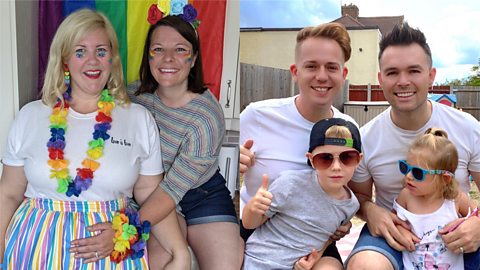
How to talk to your child about different family units
Here are ten top tips from Sarah and Laura and Rich and LewâŠ
1. Build the foundations
If your child asks, âCan two men get married?â Rich recommends answering the question simply - yes! âThereâs no need to go into the law or the reasons why same-sex marriage is now allowed. Thatâs far too much for their little brains! Instead, simply say that yes, two men can get married, and so can two women, and so can a man and a woman. Itâs who someone loves and thatâs it. We also use craft activities to explain in an age-appropriate way. We get cutouts of different people and then use them to make little families. We explain all the different types of family setup you can have. It helps build a foundation for when they are a bit older and can understand more.â
2. Be prepared
Another question your child may ask is, âWhat does gay mean?â You could say it means two men or two women love each other and that people love each other in different ways.
âIf you try and explain to a child the term LGBTQ+ youâre setting yourself up for a difficult discussion with a young childâ, says Rich.
âGet involved in what your school is teaching about diversity. If you know what your child is learning in school, youâll be more prepared for the questions they might ask and have the answers.â
3. Keep it simple
There is a lot of history around Pride, but for now, Laura suggests keeping conversations with your child quite general. She says, âFor preschool age or younger, talk about accepting everyone for who they are. Children arenât born prejudiced, they are born curious. Itâs important to answer them kindly and in a matter of fact way.â
Lew adds, âWe say to our kids that families may be different but they all have one thing in common - they love each other.â
4. Use books
Whether itâs single parents, two mums, differently-abled parents, a mum and dad or grandparents raising the kids, there are lots of different family units. And a great way to start the conversation with your child is through childrenâs books.
Sarah says, âIf you see an LGBTQ+ character or same-sex parents, make sure to point them out and use it as an opportunity to reiterate that families come in all shapes and sizes. If you don't have any books that show different family dynamics, buy a few, or borrow from a library - reading materials/pictures in books tend to have a big impact on kids.â She and Laura like to read Who's In My Family?: All About Our Families by Robbie H. Harris. This book shows all sorts of families, so is a great opportunity for parents to point out different family units with happy children.â
Rich and Lewis read Two Dads by Carolyn Robertson to their children. The book is about a boy who has been adopted and is raised by two fathers.
5. Donât worry if you donât have all the answers
Children have lots of questions about everything. And even if you donât have the answers, thatâs okay. Rich says, âItâs easy sometimes to say, âOh donât worry about thatâ or âshushâ them, but that creates confusion and leaves the question unanswered. Sometimes you might shush them as you donât want to have the conversation because you donât know the answer or youâre worried youâll say the wrong thing. But actually, there isnât a 'wrong' thing. Itâs better to have the conversation even if it leaves you as a parent thinking, âactually, I need to find out a bit more about this myselfâ.â
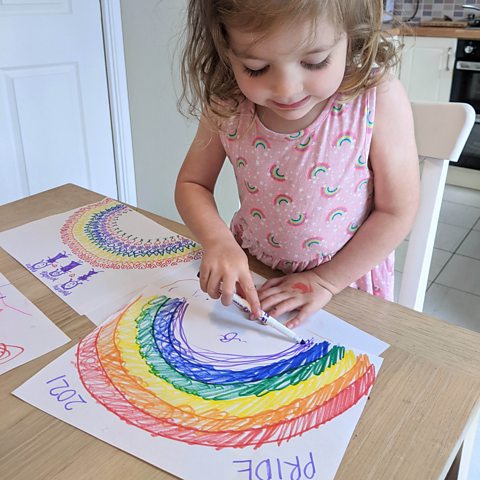
6. Keep the conversation going after Pride
Sarah recommends talking to your child about families - and how every family set-up is different - all year round. âThe celebrations and rainbow clothes spark conversations with your child which is great. But itâs important to celebrate our differences all the time.â
7. Involve your childâs nursery or school
Both sets of parents suggest involving your childâs nursery or school, and speaking to them about inclusiveness and ways to celebrate diversity.
Sarah and Lauraâs nursery put the childrenâs family photos on the wall and talk about who is in each family. âThese conversations are really important for Annabelle as sheâs never felt any differentâ, says Sarah.
Rich and Lewâs school have also been really supportive and recently read their sonâs favourite LGBTQ+ childrenâs book in the class storytime.
8. Start early
Your child is never too young to learn about different families. âSome people donât know other gay people so their children wonât know people in same-sex relationshipsâ, says Sarah. âItâs not intentional but it means their child might be in a situation where theyâre not aware someone can have two mums or dads. The younger you can start that conversation the better.â
9. Avoid stereotypes
Sarah and Laura suggest avoiding stereotyping behaviours that are seen in a family, like mum cooks and dad builds things. Laura says, âThis can set the expectation that a child in an LGBTQ+ family wouldn't have a parent that could do important roles in the house and can lead to conversations about who is the 'man/woman' in the relationship. In addition, everyone pitching in to help instead of sticking within traditional gender roles will give kids a well-rounded list of skills that will benefit them when they are older.â
10. Prepare your child for questions they might get asked
As your children get older, they might be asked questions by other children. âWeâve got to prepare Annabelle for someone saying, âYou have two mums, they canât both be your real mumâ, says Laura. To help, they read Annabelle the book âWhoâs Your Real Mum?â. âIn it, the child explains her mums hold her when sheâs scared and kiss her goodnight. âDonât both your mums do that?â asks the other child. And she replies, âExactlyâ.â

Books that celebrate LGBTQ+ families
- The Great Big Book of Families by Mary Hoffman and Ros Asquith
- Kenny Lives with Erica and Martina by Olly Pike
- The Family Book by Todd Parr
- And Tango Makes Three by Justin Richardson and Peter Parnell
- Who's Your Real Mum? by Bernadette Green and Anna Zobel
Find out more
- Read more about Lew and Rich's experiences as adoptive parents on their blog or by following them on Instagram -
- Follow Sarah and Lauraâs parenting journey on Instagram -


